
Oni konvencionalno-perverzni japanski dokazi da u drugom čovjeku nikad ne tražimo čovjeka.
One of Japan’s most infamous artists, Toshio Saeki
has cultivated a unique and shocking style, blending traditional
Japanese technique with his own twisted imagination. Saeki’s artwork is
the harmonious synthesis of a perverse vision and an incredible artistic
ability, challenging social norms by placing the unconscious in plain
view. - www.juxtapoz.com/


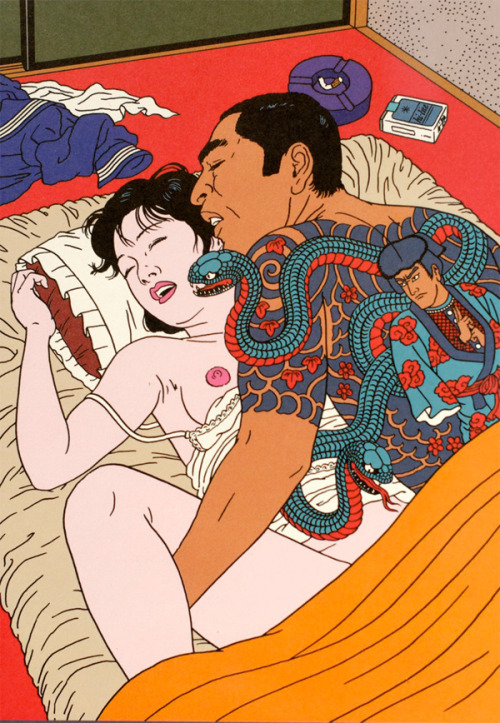


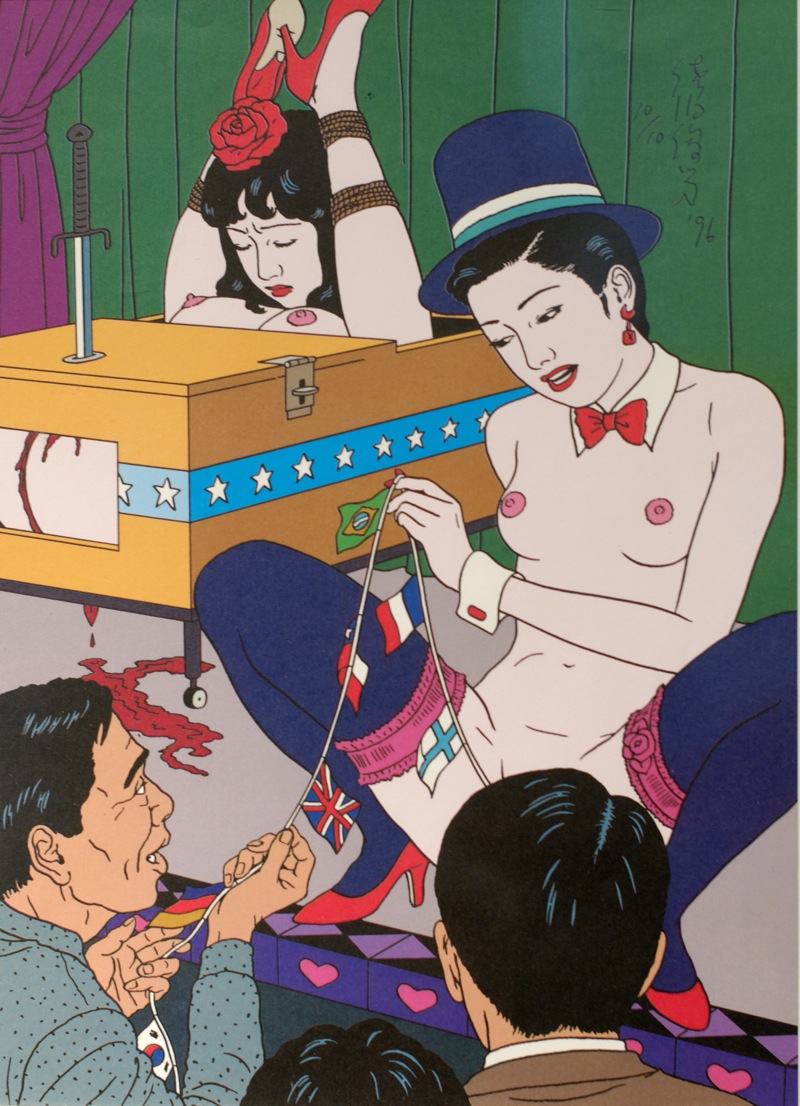
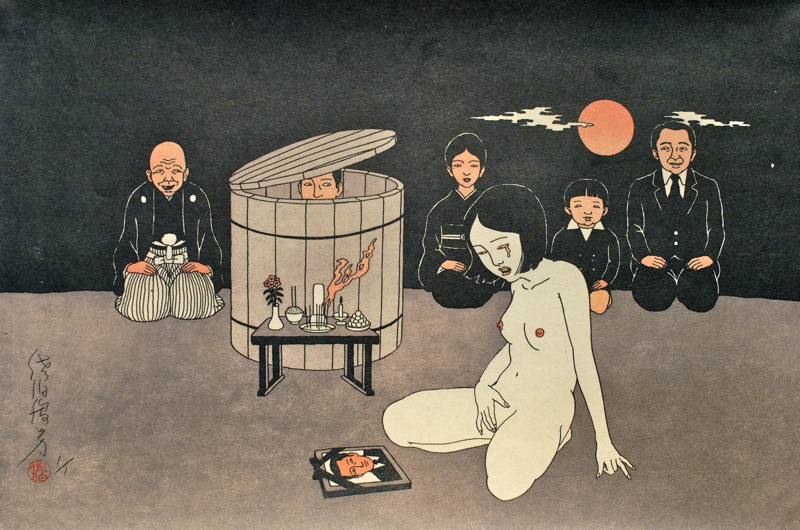
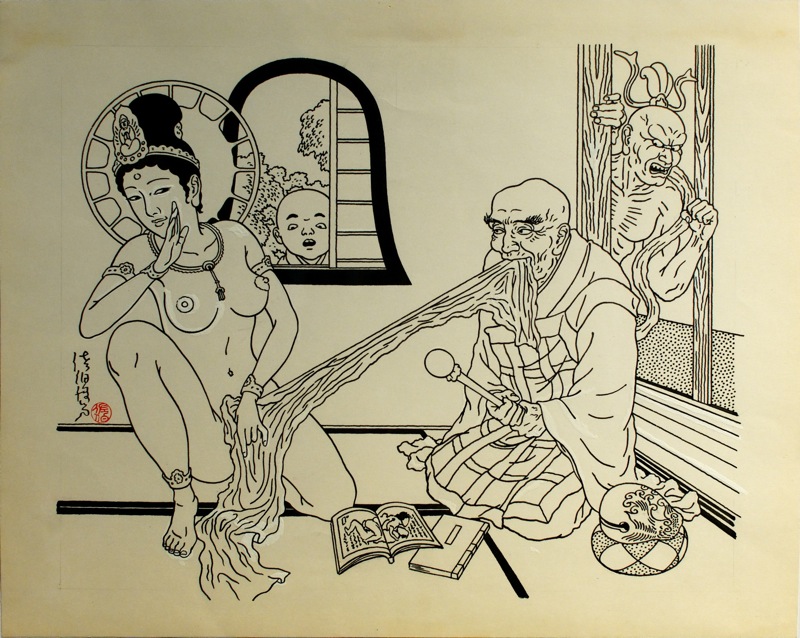
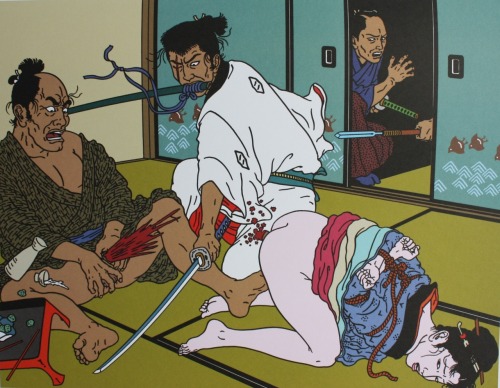
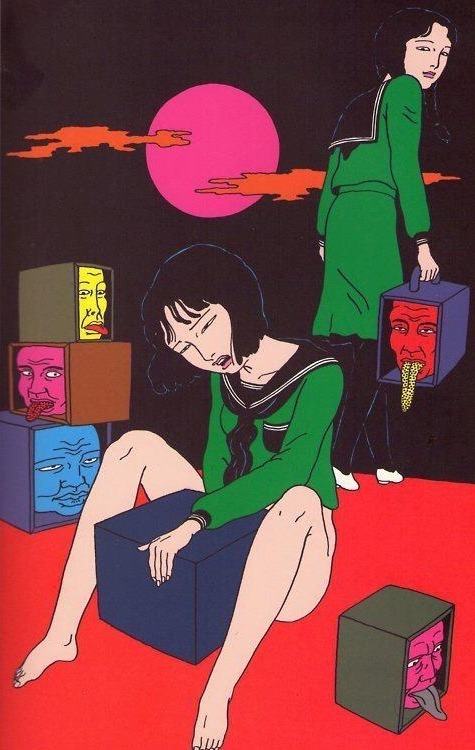
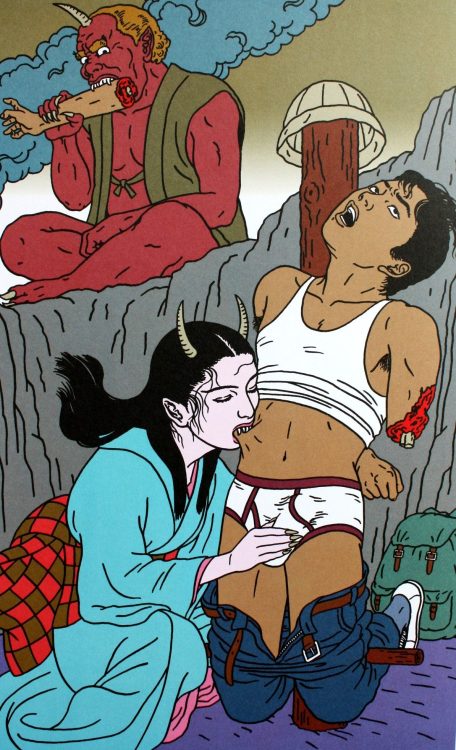
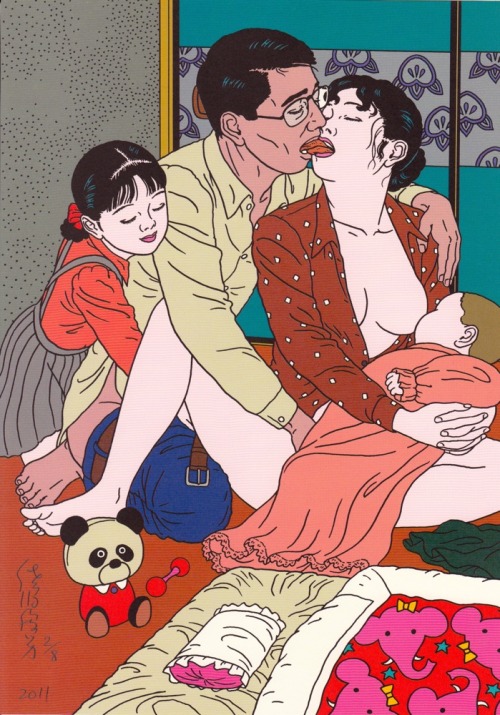
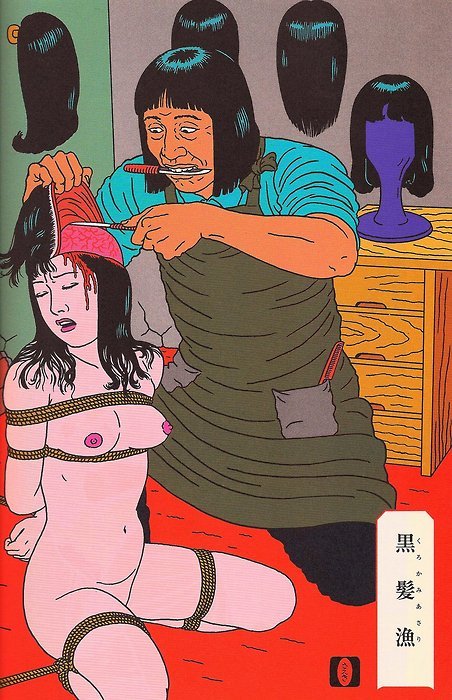




















































Toshio Saeki
Memories of 1970
When I speak about my work, I often employ the term ero. However recently, somebody whom I know gave me some advice from a museum curator: “It would be to better give up the term ero for that of Eros used in art”. But what he says, am I told! The distinction between ero and Eros, is the essence there? I felt I'd really like to ask these art specialists where they had dug up this question. To turn to the use of a word such as Eros which does not wound the ear, doesn't that neglect what makes it a taboo? To even hold at a distance a term which rejects its indecency and its vulgarity, one could not be unaware of the major nature of what it recovers. Ero is the recipient of the life of the man. Through it, death is profiled. When I adapt myself to this ero, by making it the topic of my drawings, I feel neither constrained, nor hesitant.
I became professional in 1970, a pivotal year which I cannot forget. In spring of the previous year, I had left Osaka for Tokyo, in the hope to be published. Living in a modest studio, the days during which I sought, groping, all kinds of images, ran together and were laden and heavy. Then, towards the end of the summer, to my great surprise, I found my style. I slipped under my arm fifty drawings completed spontaneously, with which I was content, and I went to make the round of publishers. They did not find them interesting; pitiless reality, I thought…
In 1970, the situation was reversed. I printed my originals and renewed my sendings. That took effect: the famous magazine for men Heibon Punch decided to publish all of my drawings on the pages reserved for the photoengravings. At the time, Heibon Punch, called “the launcher of style”, exerted an enormous influence. Shortly after the publication, the proposals of work, interviews and invitations began to flow. Even television requested me, so that finally I became professional. I remember that in the bookshops, the collection of my fifty drawings had been placed in plain sight, which encouraged me more.
In this year was announced the emergence of a new generation full with energy. There was the international exhibition of Osaka glorifying the economic performances of the country, while other striking facts, the diversion of the Yodogô plane by members of the Japanese Red Army or the suicide of Yukio Mishima performing harakiri, shook society deeply. After the Sixties at the end of the war in Vietnam, the hippie culture infiltrated all fields, but especially, the manner of living and behaviors of young people announced a revival.
Was this the atmosphere of this time? My work advanced well. My ideas were connected one after the others, inexhaustibly. During these rich and stimulative hours, I had also made the acquaintance of a charming woman. Love filled us, but it evaporated like water from dust. The year finishied sourly when one morning, in the district of Shinjuku, a gangster, holding up a knife, continued us me and my best friend, the worst being when he sliced the a ring under my eyes (?). This terribly violent moment survives in the flood of my impressions of this year 1970, and remains engraved like a wound in my memory.
The year 1970 had hardly started when I became acquainted with Shûji Terayama. He had proposed an interview with me to write an article, Essay on Toshio Saeki, which he had intended for the magazine of art La mer of the publisher Chuô kôron. He had already written an interesting text to accompany my first collection. He had shown me this text presented in the form of paragraphs of fourteen lines, in which he played with the words as only he can do so well. All the sentences were relevant but I remember one of them particularly: “Toshio Saeki is the descendant of Hatanosuke Hinomaru which violated the corpse of a little girl in costume of sailor. ”
Terayama had appeared at the cafeteria of its “Troop of the hen house”, wearing a brown jacket on a black tee-shirt with an upright collar. It was a friendly environment as if we had known each other for a long time. I had forgotten the tension generated by the idea of this first face-to-face discussion. The interview started. It related to my sexual experiments during childhood.
During preparatory school, my Uemura classmate had discreetly shown me erotic paintings from the Edo period. I believe to remember that they were prints printed on Japanese paper. The colors were bright. At the sight of the scenes represented, perfectly shameless, I was astounded then conquered by confusion. In regard to when girls and boys test each other's embarrassment, I “had already played doctor”, an experiment which returned a little of my senses to me at the moment. However, I was not at all able to understand this grotesque tangle of bodies. I had been doubtless convinced that they were drawings skilfully carried out by the insane, applying an indecent imagination to unreal scenes.
“Which were these postures? ” Terayama asked me, a smile on his lips. Taking up a pencil and a piece of paper, I thought that it was a point which would remain between us. Very simply, in some strokes of pencil, I reproduced the forms in sitting position, view from the top. When I handed the drawing to him, he slipped it into the bottom of his pocket like a treasure. Sometime later, I was not surprised to discovere this sketch in the magazine, at the head of his text. The article, far from presenting a stereotyped vision of the World of Toshio Saeki, reflected the man who I actually was. And through the page layout, Terayama proved well his skill at the setting of a scene.
At the time, I had reflected much on the idea of eternity which my work reflected besides, but about which I had never spoken. “Why only this way? ” he asked me. I felt a stinging in my heart. What Terayama pointed out as if it were clear as day, I had kept a secret. “Why indeed…. Only one way of expression, and what's more, continues indefinitely. ” I had answered allusively, keeping me from pronouncing the word “eternity”. However, in his text, he finished on these words: “This single way is a metaphor of the rebirth […] In this way, and in opposition to any modernity, the ego dies and then reappears in the middle of the obscure territories of the unconscious. ”
Terayama was the first person to buy my drawings. At the end of the interview, he plunged with a lively interest into the collection that I had brought to him. Titled 1970, Toshio Saeki, it had just appeared with the Gakugeishorin editions. There he gathered works representative of my work during that year. “Do you sell your originals? ” he asked me, choosing two drawings which he desired. I was touched and although I wanted to do it, I remember that one of the drawings was not saleable. It was twentieth collection. It was entitled Tea party game, and it was allusive. It belonged to my first outstanding work and it had been nicely reproduced in two colors in Heibon Punch. In the beginning, it represented a strange little boy who had slipped his right hand under the skirt of a young girl but Yasuda, the editor, had complained. “That will not pass, this drawing…. ” He feared that the police force would find it obscene. The self-censorship of this meticulous editor had disconcerted me. For the first time of my life of draftsman, I became aware of what freedom of expression gives.
Yasuda, incapable of overcoming his fear, required me to begin again, in a hurry because of the imminent deadline of publication. I, for want of anything better, had cut out the disputed parts which I then replaced by blank paper. The hand of the boy, outside of the skirt, held a bowl. The drawing was submitted again, the problems were avoided. This is why, I explained, this parcelled out and recomposed image, could absolutely not be sold. “But that suits me! ” said Terayama who, with his brilliant eye, wished for it even more. It was typical of his behavior because with his experiments of street theatre, he scrambled the borders between fiction and reality. Or perhaps he was delighted by this drawing which, through these corrections, kept the appearance of social suitabilities.
One day, during a conversation with the singer Maki Asakawa, she said to me: “I went to Terayama. I saw your drawings hung there. ” By hearing her, I had felt invaded by the same joy I felt at the time of the transaction. My luck at that time was to have known talented and anticonformist beings in all fields. I owe much to Terayama, without ever having been able to show my appreciation to him.
In the depths of my heart, exists another benefactor, following the example Terayama, which I could not thank enough. At the beginning of the spring of 1970, I descended from the station of Kitakamakura, on the Yokosuka line. I walked on a calm way bordered by bamboos, when a proud white house appeared to me in the distance. Tatsuhiko Shibusawa, specialist in French literature, lived there. At the request of my publisher, he had written a comment on my first drawings. I was to come myself to seek this text because I made a point of thanking him directly.
His wife introduced me into the living room. Five minutes later, Shibusawa entered, holding with his hand the manuscript that he had just finished. He, in front of me, was dressed in good taste, a peaceful impression emanated from him, which rather gave him the air of an impassioned young person of literature. I greeted him, awkwardly, but when I finished reading his text, I saw beers on the table. “What! That's not all! ” he said to his wife. She placed dried squid which they had probably received from the countryside. I had arbitrarily imagined from I do not know which reading, which he would have a European lifestyle, so that on seeing the squid and beer, typically Japanese food, I had felt suddenly invaded with sympathy. His wife also brought sushi. It was still daylight, and a small feast started. I was completely full. I know today only I had spoken, but Shibusawa listened with a benevolent glance, accompanied by discrete consents with my stories about a young man left nowhere of which he knew only his funny drawings. His cordial attitude gave me a real sense of security. An air of kindness floated around him. The smoke of his pipe and his soft smile composed a harmonious table.
Shibusawa had translated Histoire de Juliette ou les prospérités du vice du Marquis de Sade [The Story of Juliette or the Prosperities of Vice of the Marquis de Sade], a translation which he continued on in search of justice for obscenity. Asserting the legitimacy of this literature, he had run up ten years fighting against the authority of the State, and this conflict had had a deep repercussion in the world of letters and philosophy. He had finally been condemned, whereas today l’Histoire de Juliette ou les prospérités du vice is enthroned in the bookshops, missing only one final amendment not added from his translation of the original. I cannot prevent myself from thinking of the kindness that he had shown me then, that is something which only irreducible men can claim.
“Look at this”, Shibusawa tells me, handing me a booklet on German art. While turning the pages, I catch my breath. Erotic drawings painted by a Japanese artist were presented there. “It is from Shôen” I said. Shôen Uemura is one of the largest artists of the Shôwa era. He had created an incredible scene which left me speechless for a few minutes.
The image represented voyageuse, the wife of a samurai it seemed, that two infamous and hideous carriers of a palanquin violated. Contrasting with her air full of nobility, the hairs of her fine and dark pubis were disproportionate. Her sex, absorbed a penis alike a root of pine. The ecstasy written on her features was deformed by anguish, and this appalling spectacle was like the insane blossoming of a flower of hell. This splendid erotic painting, concerned with the directions of pleasure, reserved for an informed public, was the work of a woman, and I felt disturbed by the fact that it concentrated on a scene of rape. I had the impression to try to learn to seize through this drawing what had been her desire and her feeling.
To admire erotic paintings of Shôen, I had passed with Shibusawa one moment of happiness. In looking at the walls, I had suddenly noticed an illustration of Tadanori Yokoo. I do not know what came over me when I said high and strong: “If I launch out in erotic painting, I will yield nothing of it to Yokoo!” Was I under the effect of alcohol that I had felt able to measure myself with the most famous draftsman of the time? “Oh! How I hope to see that! ” Shibusawa answered with a smile of pleasure. How had I returned home this day? I do not have any memory of it. Perhaps this was coated with a feeling of happiness.
A few days later, in accordance with my promise, I launched out in erotic painting, but curiously, I did not arrive at anything. I was full of spirit for the idea to carry out a work which would have really satisfied Shibusawa, then I had shed this prospect off myself with a heavy pressure. I had gone back to the work many times, without managing to draw. When in a weekly magazine or a review, I happened on an article where he [Shibusawa] spoke of my work with praise, I would have liked to become very small, the smallest possible.
It may be that in the eyes of Shibusawa, we had done nothing but have one light conversation without consequence. However, I didn't feel that way. If this busy man had invited me, on a journey with empty hands, without one of these paintings. Sometimes, this memory comes up and I take my brush, then the coward, burying this project in my daily activities. The occasion to please him is lost then forever. It is my greatest regret. And yet, the kindness that he had shown me at the time of our meeting, has comforted me several times, later, throughout my life.
Three months had passed since I had acquired the status of professional when the editor of the magazines where my drawings were printed, as his associates, were raided by the police force. They received a warning. The third time, they would fall under the blow of a prohibition of publication, and the person in charge of the offence would be tried for obscenity. The prohibition of publication for a small house of publication was likely to carry a fatal blow to it. Thus, it was a serious problem.
At the beginning of my career I was neither constrained, nor hesitant when I chose the eroticism as a topic, even if I were told to take precautions. The sexual topics that inspire loathing in the majority of people will always entêteront[?] themselves in their aversion. The world of art can choose the high or the low road with its hot head. That was not the road I decided to follow and for me, it was good after all because what counts in the end is going to the front. Such was my year 1970.
January 2006
(Translated from Japanese by Beatrice Maréchal)
[Translated to English by AkaTako.net] - www.akatako.net/

Toshio Saeki was born in Miyazaki, Japan and was raised in Osaka. Aged 24, he moved to Tokyo, at a time when the sex industry was exploding. Saeki quit a day job at an advertising agency after a few months, and wound up contributing to Japanese cult men's magazine Heibon Punch, who 'showed women how to pose to provoke their boyfriends'. It was his work for HP in the 60s and 70s that would pique the interest of the contemporary scene: worldwide exhibitions followed and his work received international acclaim.
Saeki's extreme, intensely controversial images relate simultaneously to modern and ancient art practices. The provocative tendencies of the artist's crazy mind are, for example, inspired by childhood nightmares, scenes from his everyday life imprinted on his photographic memory, the stars of 'Ginei' movies and Western comics. At the same time, Saeki addresses medieval Japanese art - known as 'ukiyo-e - with his 'Chinto' method of printing, according to which the Eshi (artist) and the Surishi (printer) share a unique rapport.
Saeki's creations began as entertainment for his school friends, and they entertain still with their disturbing charm, a kind of erotic horror show. The artist meanwhile is now approaching 70 years, living somewhere in the Japanese wilderness.
(Full disclosure – the art gallery I help run, NO WAY are happily producing the first ever UK show of Saeki's work, at London's Print House Gallery in March, thanks to Ghostown, who open his first show inside Israel in Tel Aviv this week.)
Why does violence feature so prominently in your work? Toshio Saeki: Let me put it this way: leave other people to draw seemingly beautiful flowers that bloom within a nice, pleasant-looking scenery. I try instead to capture the vivid flowers that sometimes hide and sometimes grow within a shameless, immoral and horrifying dream.
The works are at times frightening, while at other moments they contain humour. Where does this come from?Toshio Saeki: I’ve always been attracted to scary and paranormal things because they are mysterious. I love enigma and things that aren’t easy to understand. As for humour, I grew up in Osaka which is to the west of Tokyo, where people value sense of humour and everyday conversation is full of jokes, so maybe I get that from there. But the humour in my work is not intentional. I never realised that aspect existed within it, until someone pointed it out to me.
There is a recuring motif in your work of physical sickness – portraying diseased and decaying characters, often engaging in extreme sexual acts – why is this?Toshio Saeki: I had a sickly father and as a child, and, since we did not live in a big house, I often saw him being examined by a doctor at home. I was scared and worried, but at the same time, very curious. Perhaps my inspirations come from this kind of experience in my childhood.
Women are often bound with ropes in your work – what effect do you feel this has?Toshio Saeki: In my life, I’ve done lots of work drawing images for magazines and books. And I’ve done lots of work for S&M magazines so that’s probably the reason that there are many images of women bound with ropes. But that might not be the only reason. I have a strong proclivity towards finding universal truths in things that are looked at with disrespect and treated coldly, or driven away from society. And it’s true that all sorts of vulgar and indecent aspects of sub-culture expanded the scale of my works.
Though your images often depict extremely violent acts – mutilation of genitalia and so forth – the characters experiencing them, both men and women, however, do not often seem to show pain – do you see the figures as consenting?
Toshio Saeki: Let’s not forget that the images I draw are fictional. Depicting the character’s faces without pain or suffering brings out the effect of the “unusual and extraordinary.” Whether or not the figures are consenting or not does not really matter to me.
Do you work from imagination or do you have models pose for you?Toshio Saeki: All of it comes from my imagination, although sometimes I use photos or references to check the details like patterns on the lining of a kimono, etc. But overall the picture is all from my head. Since I was a child, I think that I was always keeping a stock of memorable images. When working on a new drawing, I wait until the appropriate images from my stock falls out in a natural way.
You often draw an onlooker or observer into the scene. The conscious surfacing in the subconscious?
Toshio Saeki: I think that your interpretation is not wrong. The appearance of a third person makes the scene more dramatic, whether one likes it or not. By having an onlooker peeping at a secret act, that gives the scene more meaning, and makes the picture more fun.
One of my favourite works is the image of a woman slicing her breast into a kneeling man’s mouth – can you talk a little about this image?
Toshio Saeki: I only explain myself through my drawings, I can’t put into words what the images mean. It would not be difficult for me to come up with various arguments concerning the images, but that will distort the understanding of the works for sure. Your sensitivity that you find this work to be your favorite is the most truthful and accurate view of it.
How do you feel about the appropriation of your images, and about the responses it elicits from women's groupsToshio Saeki: Recently, many women come to see my exhibits; I think this shows that people are starting to understand that my works do not encourage violence to the observers. On the other hand, I've never wished to draw anything that would be favored by all people, and I try to capture people's attention through horrifying visuals and terrifying illusions, so I'm aware that antipathy from a certain group of people or society in general is unavoidable. As for people using my work, that's not a problem concerning just my work, and if there's any way to prevent it, I'd really like to be informed.
Interview by Charlotte Jansen & Maki Hakui - www.dazeddigital.com/


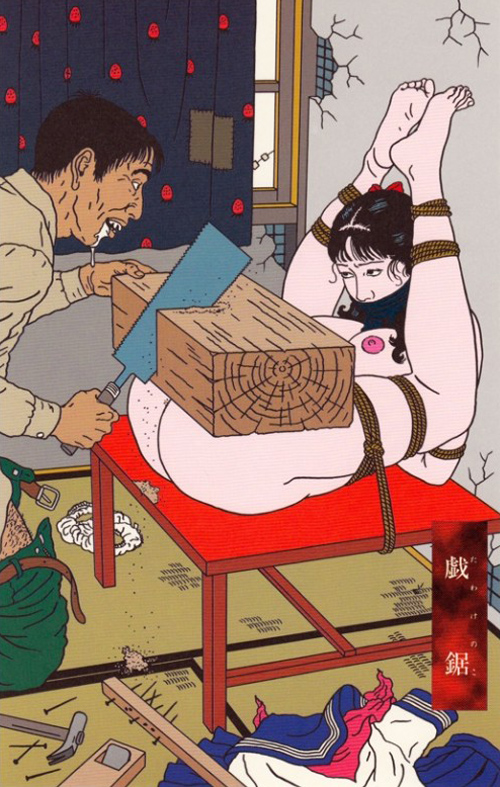
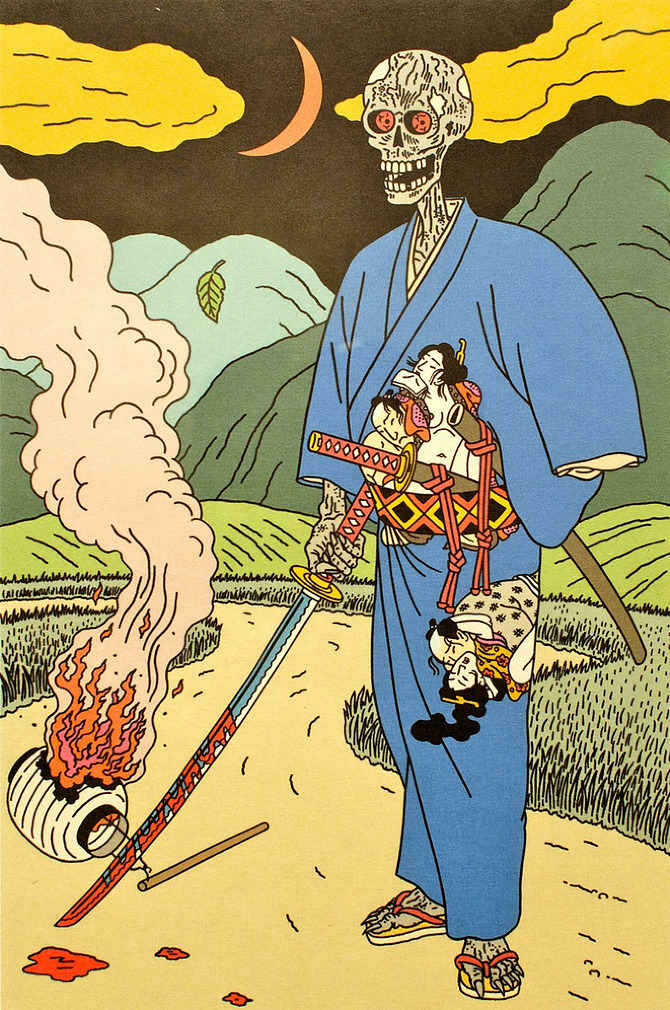

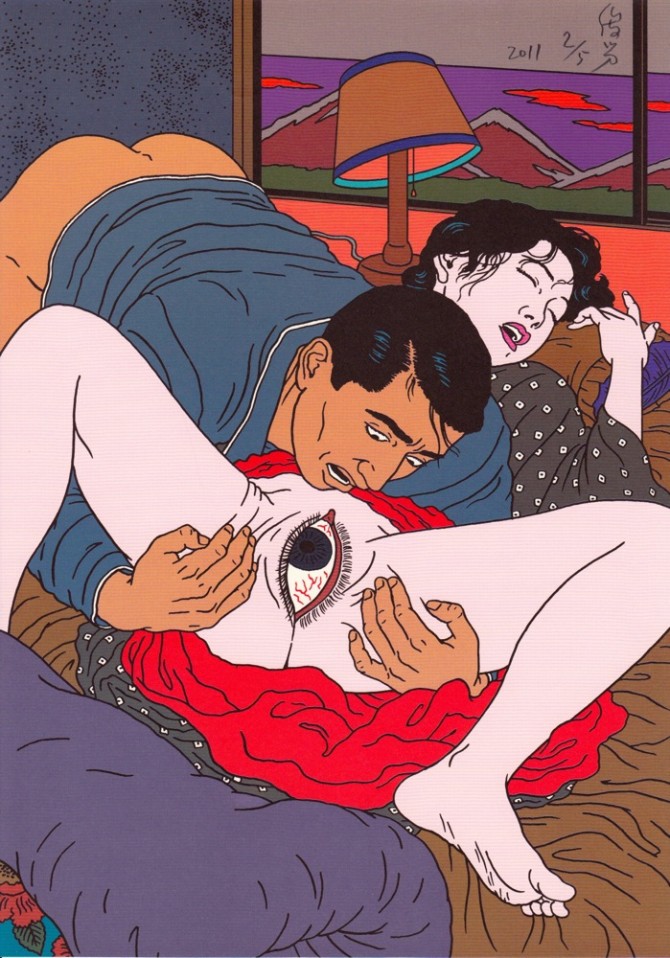
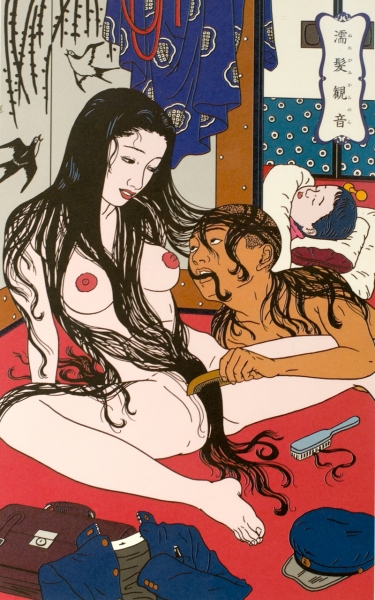
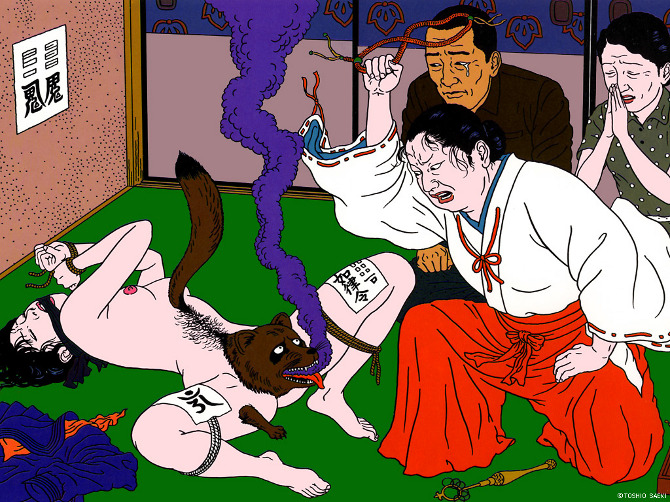


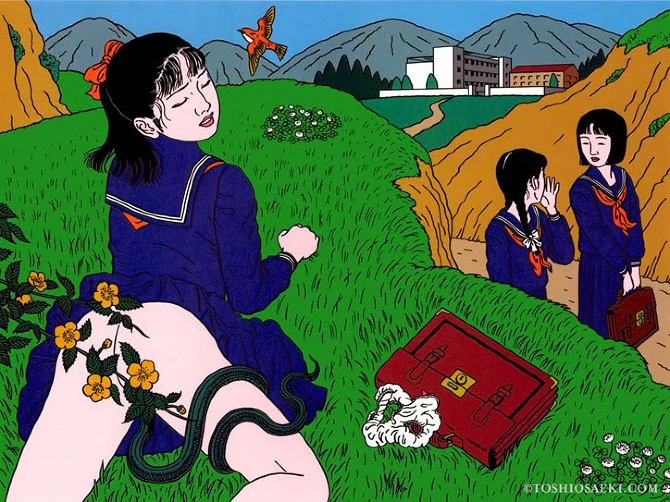
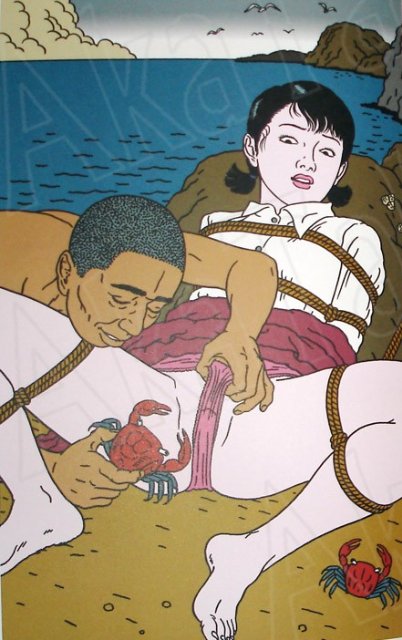
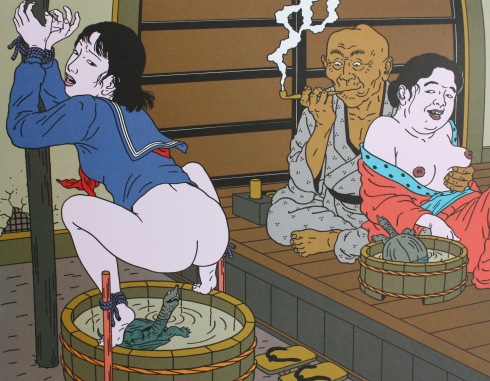
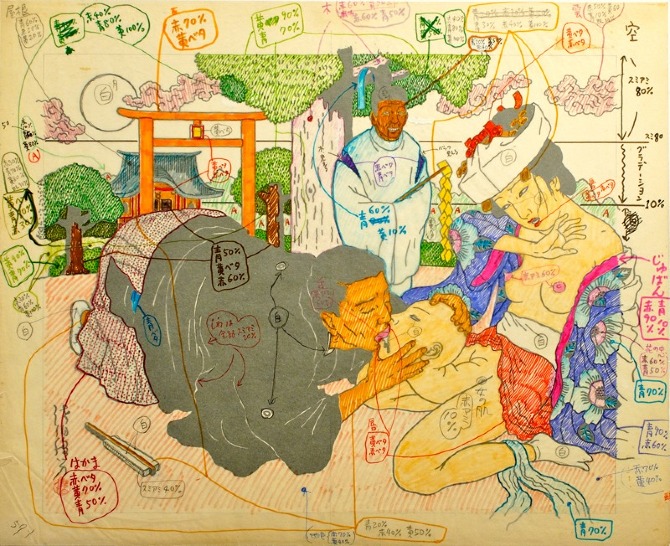
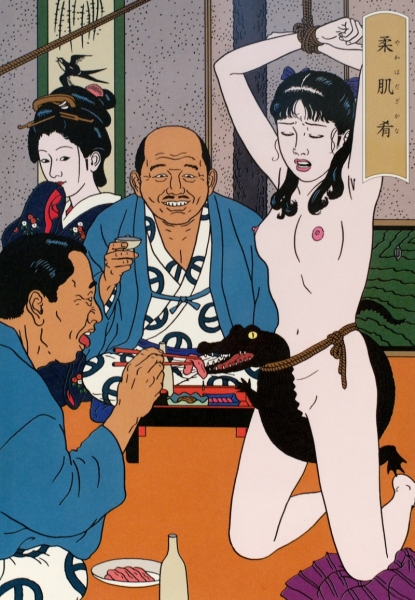
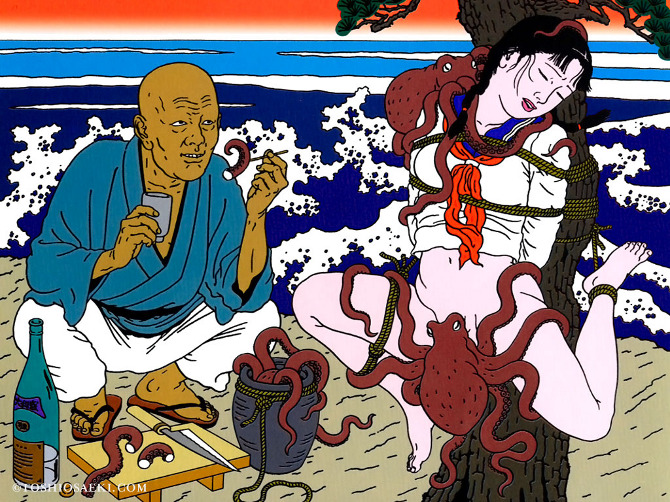


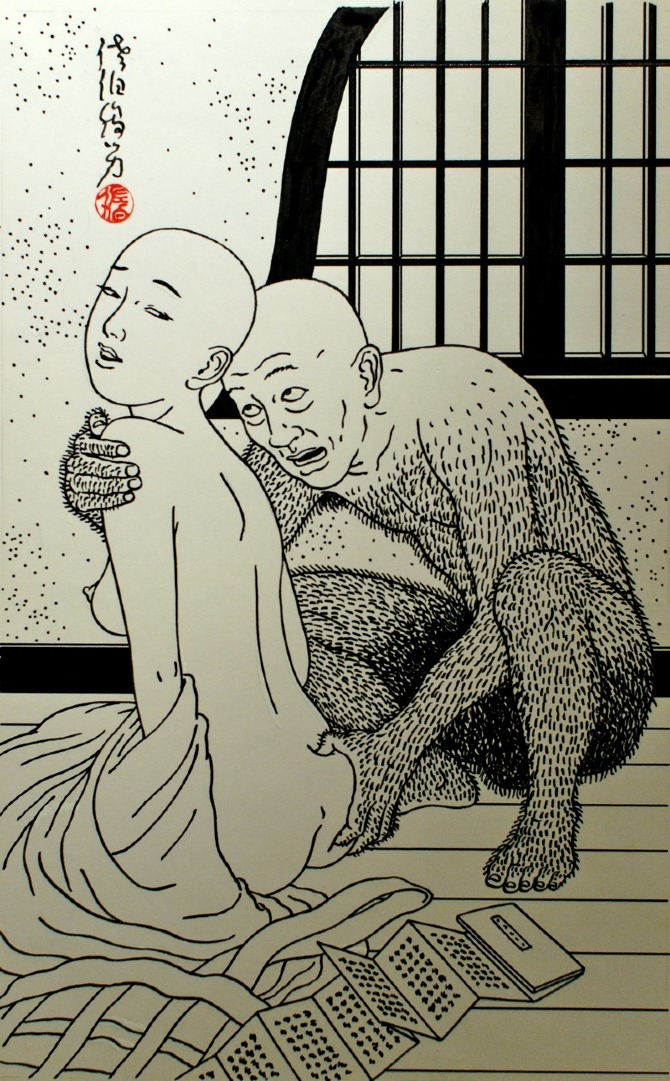

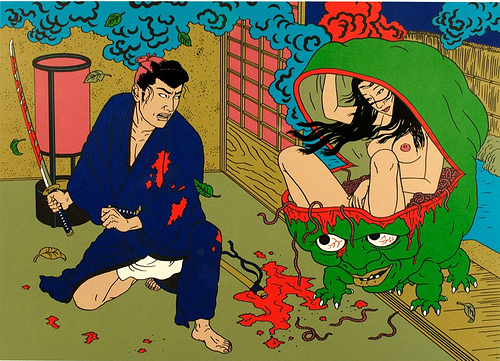
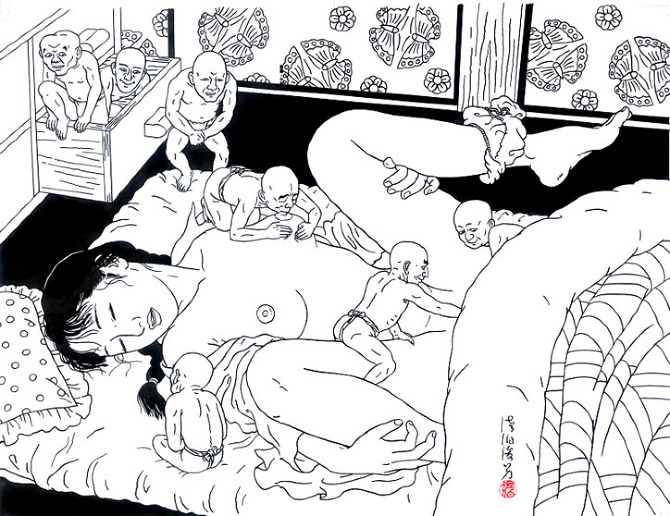
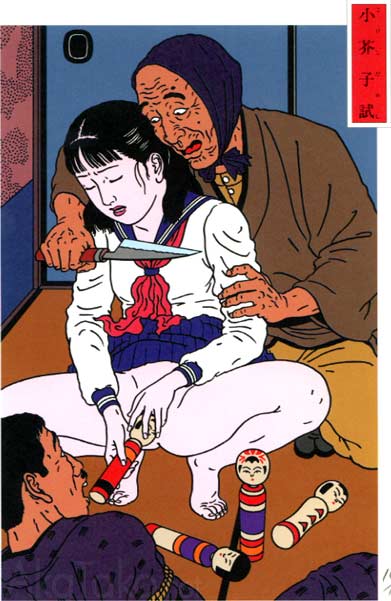
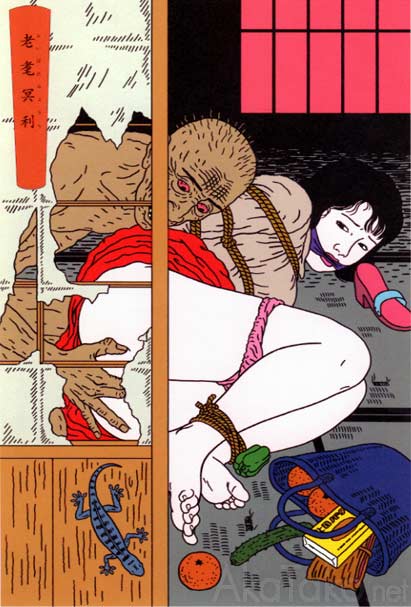




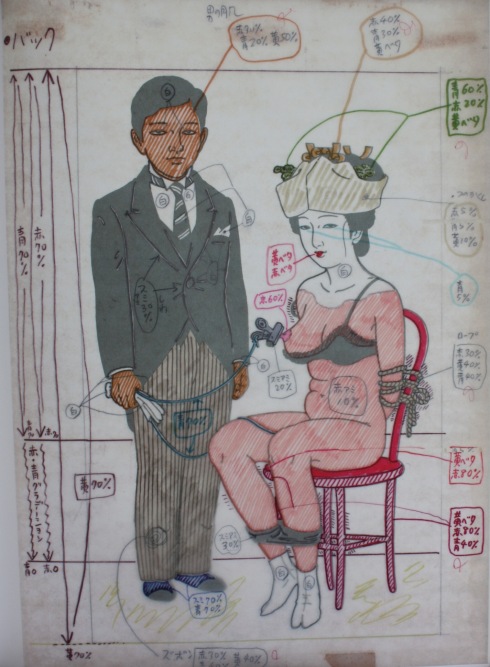
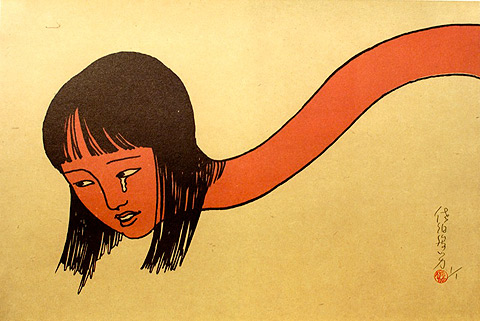
Nema komentara:
Objavi komentar